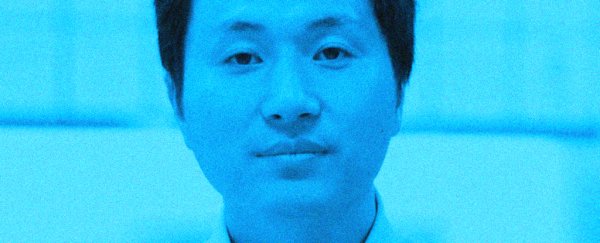It was the most explosive scientific controversy of 2018: Chinese scientist He Jiankui brazenly announced in November he had created the world's first gene-edited babies using CRISPR.
He's admission – including that twin girls called Lulu and Nana from his experiment had already been born – provoked immediate international uproar in the scientific community, with critics decrying the geneticist's flagrant flouting of ethical standards and scientific regulations.
Ever since, Chinese authorities have denounced He and distanced themselves from his supposedly secret, independent research, but new documents coming to light suggest he may not have acted entirely alone after all.
Last month, Chinese investigators said He's privately funded experiments involved fake and forged certification and samples, but while his methods may have been his own, it looks like the money behind the research might not have been.
Documents seen by medical news site STAT suggests He's CRISPR babies research was actually funded by three separate government institutions in China, including the Chinese science ministry.
So far, there's no solid proof these funding bodies knew specifically what their money was being used for, but some voices in the research community suggest the Chinese government had to be aware of He's work – just like some scientists were before news broke about the controversial experiments.
"I don't think He Jiankui could have done it without the government encouragement to press ahead" bioethicist Jing-Bao Nie from the University of Otago in New Zealand told STAT.
"They want him to be the scapegoat, so everybody else can be vindicated. But this would disguise serious institutional failures."
According to the site, in contradiction of the official line that He acted alone and without endorsement by any government bodies, documents show government funding directly or indirectly enabled the CRISPR babies research to be performed.
Specifically, three different kinds of documentation indicate funding came from three different sources in the government: the Chinese Ministry of Science and Technology, the Shenzhen Science and Technology Innovation Commission, and Southern University of Science and Technology (He's employer).
STAT says the funding sources are listed in research presentation slides prepared by He's team, patient consent forms filled out in relation to the research, and in a registry for Chinese clinical trials – which also specifies five fertility clinics involved with He's gene-editing research.
Again, there's not yet anything showing these organisations explicitly funded or knowingly oversaw the CRISPR babies work. It's possible He used up money left over from previous grants from the institutions, or even intentionally listed the government sources as funders to give his newer experiments an appearance of credibility.
But while that may be the case, if the funding sources are listed accurately, that goes against what Chinese authorities have so far said in their investigation into He's conduct, and also against what He himself has said.
In November, in He's first appearance since the research was made public, the scientist said he bankrolled the procedures with his own savings and using startup funds (affiliated with his university).
Apart from that academic connection, however, the rest of these alleged funding sources look to be new, and they make an already murky mystery even more so.
However He got away with it – and regardless of what financial backing he did or did not have – researchers say it's time for the Chinese government and scientific community as a whole to learn from this incident, and prevent it ever repeating in the future.
"China has to acknowledge that it's a problem," bioethicist Hank Greely from Stanford University told STAT.
"Even if He acted alone, which is a big if, there should have been institutions that could have prevented that."
